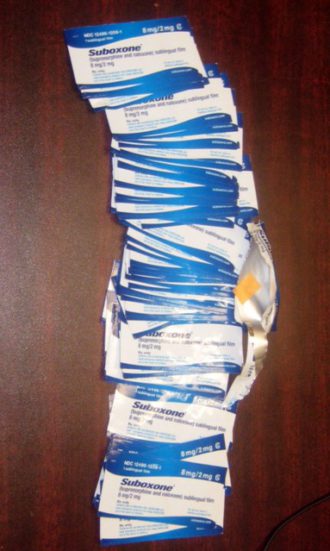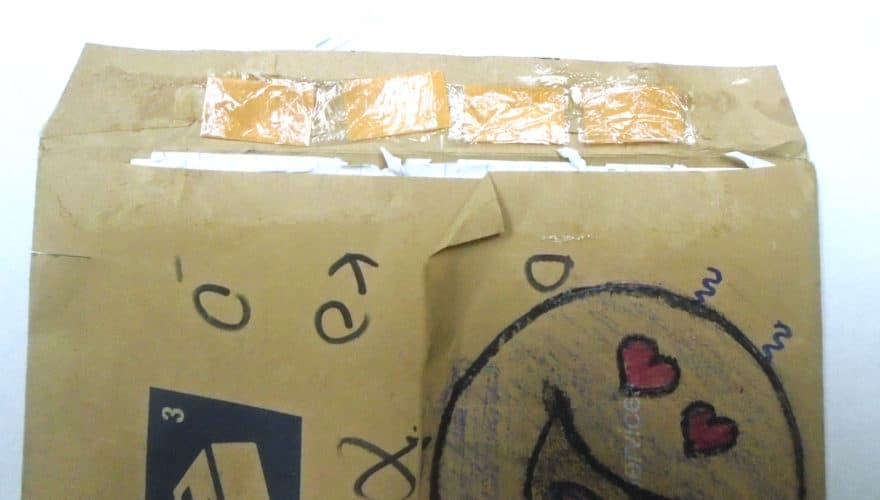The agency that runs North Carolina’s prisons has a Flickr account. It’s littered with pictures of contraband confiscated from people incarcerated across its 55 facilities: pounds of tobacco, cell phones, marijuana in a shoe.
There are also photos of hundreds of Suboxone strips.
Suboxone strips aren’t like other illicit drugs — they’re a treatment for people struggling with opioid use disorder.
“Last year in the prison system, the number one snuck-in illicit substance was Suboxone,” said Lauren Brinkley-Rubinstein, professor and public health researcher at the University of North Carolina School of Medicine.
People are 40 times more likely than the average N.C. resident to die of an opioid overdose within two weeks of their release from a North Carolina prison or jail, according to a study conducted by researchers from state agencies and experts from UNC Chapel Hill.
Medication-assisted treatment (MAT) is a therapy that’s considered best practice for treating opioid use disorder and helps prevent overdose and reduce the risk of relapse. Currently, state prisons do not offer MAT to inmates.
The N.C. Department of Public Safety and Department of Health and Human Services had a plan to pilot MAT programs in three prisons — but this initiative has been stalled due to COVID-19.
As opioid-related overdose deaths are on the rise in North Carolina and nationwide, contraband numbers from the state prison system suggest the demand for medication therapy for opioid use disorder remains high during the pandemic.
What is MAT?
Medication-assisted treatment (MAT) uses medications, often those that act on opioid receptors in the brain, to suppress withdrawal symptoms and reduce drug cravings. It’s a therapy for opioid use disorder that avoids the painful experience of withdrawal.
The Centers for Disease Control and Prevention consider it a best practice for preventing opioid overdose deaths, according to their 2018 report “Evidence-Based Strategies for Preventing Opioid Overdose: What’s Working in the United States.”
“It highlights what science has demonstrated as the most effective ways to prevent opioid overdose that have been implemented in the United States,” said Jennifer Carroll, professor of medical anthropology at Elon University and the primary author of the study. “MAT in jails and prisons is one of them.”
MAT involves the use of one of three U.S. Food and Drug Administration-approved drugs — buprenorphine, methadone and naltrexone — which can be used safely throughout a person’s lifetime to mitigate overdose risk. (Suboxone, a common type of contraband in prison systems, is a brand name for a formulation of buprenorphine.)
“I think it’s really important to make sure that everyone has access to the medication that’s right for them,” said Elyse Powell, state opioid coordinator for the N.C. Department of Health and Human Services. “So in an ideal world, each person has an option, but obviously for some medicines there’s a large amount of regulation.
“Buprenorphine and naltrexone are a little easier to do than say methadone, which has to go through specific federal vendors.”
Studies show people are more likely to die of overdose after release if they’ve undergone detoxification, or the process of completely removing all addictive drugs from the body, while incarcerated.
“Relapse is normal,” said Carroll. “That’s why these medications, especially methadone and buprenorphine, are so effective at preventing fatal overdose. If you relapse while you have a good opioid tolerance, the heroin that you buy off the street is less likely to kill you than if you have no tolerance because you’ve been abstinent.
“It’s also why being incarcerated in a place where medication is not provided increases overdose risk. Cause they’re just as likely to relapse as anyone else, but you’ve taken away their tolerance.”
Treating opioid use disorder in prison

Though a widely accepted treatment outside of correctional settings, MAT use in jails and prisons is sparse.
“The vast majority of jails and prisons don’t provide medication for opioid use disorder at all to non-pregnant people,” said Joseph Longley, equal justice fellow for the American Civil Liberties Union National Prison Project, who focuses on expanding access to medication for opioid use disorder in correctional settings.
He noted that about half of all facilities nationwide, including the North Carolina Correctional Institute for Women in Raleigh, provide MAT for pregnant people, but cut them off after giving birth.
“It’s extremely rare right now,” said Longley. “But it’s a growing number.”
An estimated 120 jails across the country and 10 state prison systems now offer some form of medication treatment for opioid addiction, according to a Pew Research analysis conducted earlier this year. That’s triple the number offered in 2018.
“It’s pretty regional in my experience,” said Brinkley-Rubinstein. “In the Northeast and the West Coast, there’s more progress around MAT. If you look at the southeast, there’s in general less availability of MAT in correctional settings.”
Three states — Rhode Island, Vermont, and as of a few weeks ago, New Hampshire — provide MAT programs in all of their correctional facilities.
Rhode Island is a unified prison-jail system, with pre-trial detainees housed alongside convicted prisoners. The state has had a MAT program since 2016.
The program’s implementation has led to a 60% decrease in overdose deaths among people who were recently incarcerated, according to a review done by Brinkley-Rubenstein and researchers from Rhode Island.
Reservations around MAT
Health experts said many prison officials are hesitant to adopt MAT programs because they fear the medication will end up in the hands of a person to whom it was not prescribed — something that’s known as “diversion.” Many will cite high contraband numbers from people attempting to smuggle these medications into facilities.
“Oftentimes when it’s diverted, it’s diverted because that other person needs it too,” said Powell of DHHS. “And so I think that’s just more evidence that these programs are actually needed.
Of course I’ve heard many concerns as I’ve talked to different partners. And I think that’s part of the power of lifting up programs who have already been done, including programs in North Carolina.”
Brinkley-Rubinstein, who has researched MATs in Rhode Island and North Carolina jails, said recreational use of these medications is relatively nonexistent.
“It’s very hard to overdose on suboxone, so its use is therapeutic,” she said. “These myths around like using it recreationally are just that — they’re myths. Diversion instead happens simply because MAT isn’t provided.
“If they allowed Suboxone in the door to treat people’s opioid use disorder, there wouldn’t be illicit use,” she continued. “In Rhode Island, we did qualitative research where we asked people who were incarcerated and staff at their facilities what the general benefits of their MAT expansion were. And across the board people said, ‘When we allow methadone, Suboxone and naltrexone to be provided here, there was way less illicit drug use.'”
Carroll, who has looked at use of MAT-involved drugs in the United States and abroad, echoed this.
“In the United States, we haven’t seen that pattern [of recreational use],” she said. “Study after study after study, including studies that I have done, tell us that the vast majority of diverted Suboxone is diverted for therapeutic purposes.”
Paused by pandemic
In April 2019, NCDPS announced plans to begin a pilot MAT program in three state prisons. Still, medication has yet to be prescribed at N.C. Correctional Institution for Women, Wake Correctional Center, and Orange Correctional Center.
 “The pilot development has been suspended due to COVID-19,” said John Bull, spokesperson at NCDPS.
“The pilot development has been suspended due to COVID-19,” said John Bull, spokesperson at NCDPS.
Though no timeline is set, he added, “We intend to launch the three facility MAT pilots in the future.”
Meanwhile, attempts to obtain the medication by other means continue. In February 2020, prison staff confiscated 44 Suboxone strips, pills or pieces, according to NCDPS numbers obtained by public information request. That number increased every month until June, when 296 Suboxone substances were confiscated.
Bull credited this increase to better use of the agency’s “relatively new” electronic contraband tracking system rather than to a leap in the amount of suboxone smuggled into prisons.
“In short, we think this computerized system is being used more now than earlier in the year, he said. “In the past, contraband interdictions were kept on paper at the facility level.
“Suboxone is a much-desired drug in the offender population. We have seen no trends or patterns that show Suboxone is in greater demand at different times of the year, or that attempts to get Suboxone into the prisons have increased or decreased in recent years.”
When asked if NCDPS had any plans to integrate the two recording systems so data could present a more accurate picture of the 2020 contraband numbers, Bull said: “The prisons have been busy prioritizing the health and safety of the staff and offender populations during the first pandemic in a century.”
Jail delays

Currently, at least three North Carolina jails, which are run at the county level, have MAT programs.
Buncombe and Orange County detention centers each offer both naltrexone and Suboxone. Durham County Detention Center offers all three types of MAT drugs.
But Brinkley-Rubinstein, who researches the Durham jail program, said COVID-19 has also disrupted progress.
“The Durham folks started their program about a year ago, and they started just with ‘continuing,’ which means just [giving MAT to] people who already had a community prescription when they came in,” she said.
She said that the program was planning to expand to “Phase II,” also called “initiation,” where detainees who are diagnosed with opioid use disorder upon arrival to the jail are able to begin medication-assisted therapy for the first time.
“But because of COVID, that has kind of been put on hold,” said Brinkley-Rubinstein. “We still have plans to do it, but there’s just a lack of resources to get it up off the ground for now.”
MAT programs inside prisons and jails require staffing resources, and time, particularly during the pandemic.
“We can no longer have people stand in a medication line, for example,” said Brinkley-Rubinstein. “They instead need to have their meds delivered to their cell, which just takes a lot more staff time.”
Facilities offering methadone, like Durham, additionally require a specialized provider to administer the medication. The more detainees involved in the program, said Brinkley-Rubinstein, the more often that provider needs to come into the correctional setting.
“You want less traffic inside because that can be an exposure risk to COVID,” she said. “There are just all these really difficult decisions that are having to happen around how best to keep people safe.”
Increasing risks
The cost of putting these programs on pause is high, according to Longley. North Carolina has seen a 15 percent increase in opioid overdoses since the pandemic began.
“Some of those are happening behind bars,” said Longley.
He added that there’s been another unintended consequence from the lack of carceral MAT programs during the pandemic.
“People going through opiate withdrawal, either in a jail or prison, experience hot and cold flashes, get really sick, cough and have fevers — and that sounds a lot like COVID-19,” said Longley. “We’re seeing an issue with jails and prisons where they misidentify: Somebody they think is just going through opiate withdrawal symptoms actually has COVID-19.
“Jails and prisons are a hotbed for transmission of COVID-19, and the lack of medical care for people who have opioid use disorder is exacerbating that.”
Carroll said that the relatively lower risk of overdose death while a person is incarcerated is only half the story.
“There’s this narrative of, ‘Why do we need maintenance treatments in prisons, where there’s no drug market? Why do we need medication that reduces cravings for drugs when those drugs don’t exist in our prison system?’” Carroll said.
She pointed out that the vast majority of inmates eventually return to the community, and denying those medications for people in jails and prisons creates overdose risk.
“Without that understanding, the story can turn deadly very quickly,” she said. “It’s so much cheaper for the state to treat than to resuscitate.”
This article first appeared on North Carolina Health News and is republished here under a Creative Commons license.




Before you comment
The comments section is here to provide a platform for civil dialogue on the issues we face together as a local community. Xpress is committed to offering this platform for all voices, but when the tone of the discussion gets nasty or strays off topic, we believe many people choose not to participate. Xpress editors are determined to moderate comments to ensure a constructive interchange is maintained. All comments judged not to be in keeping with the spirit of civil discourse will be removed and repeat violators will be banned. See here for our terms of service. Thank you for being part of this effort to promote respectful discussion.